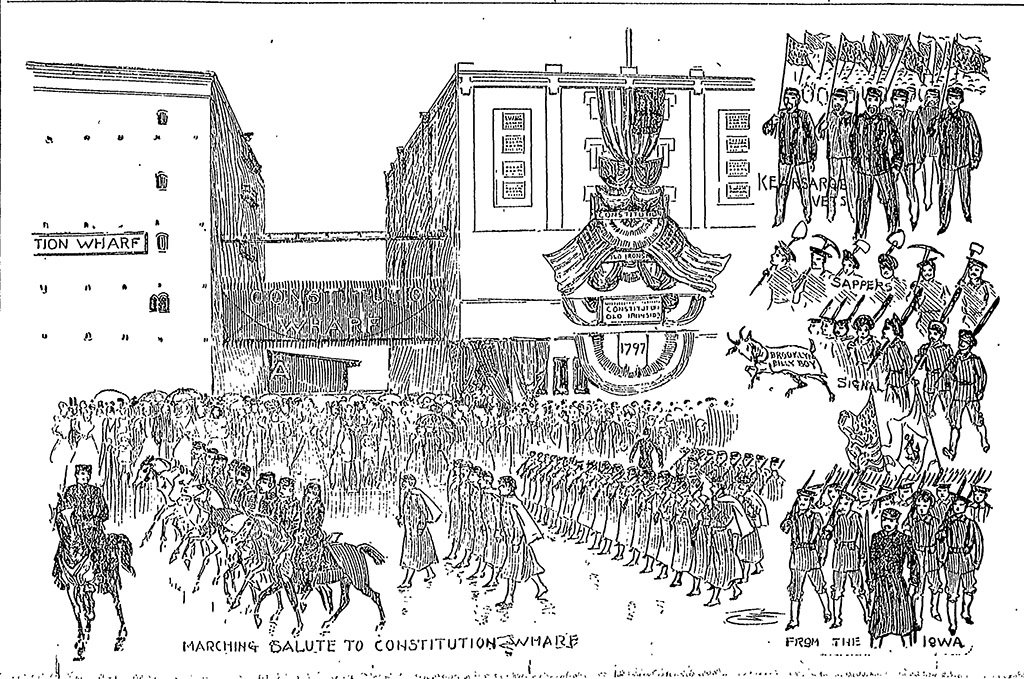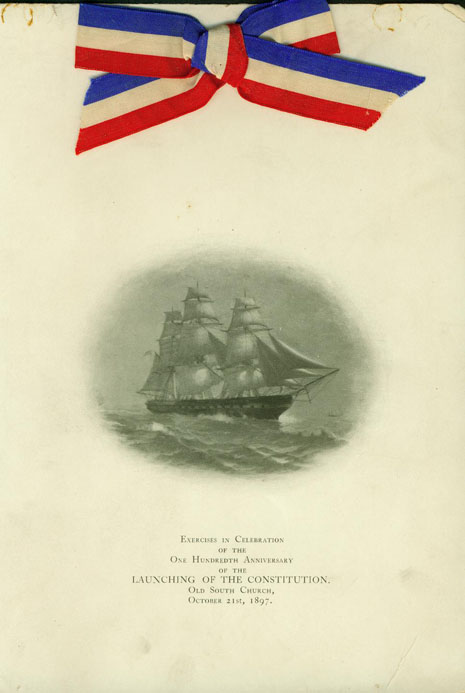On the 100th anniversary of its launch, USS Constitution came home, and Boston threw a party.
A big party.
Accounts of the ship’s centennial celebrations in October, 1897 suggest that little expense was spared in the local honors and festivities. There were parades, school activities, ceremonies, and decorations throughout the city. Other navy ships in the harbor were lit with new electrical lighting, and 500 boys from a local school led a nighttime march carrying torches through the neighborhood where the ship had been built.
For Boston, having the legendary frigate return to the city of its construction and launching was both a political and civic victory worth celebrating in style. When Congressman John F. Fitzgerald of Boston proposed relocating the ship, Constitution had been languishing in the Portsmouth Navy Yard in Kittery, Maine, for nearly 15 years. Fitzgerald, grandfather and namesake of President John F. Kennedy, grew up in the North End of Boston near where the ship was built in the late 18th century at Edmund Hartt’s shipyard. Initially, Fitzgerald had proposed relocating the ship to Washington, D.C., but pressure from local groups convinced him that ship belonged back in Boston. Fitzgerald succeeded in getting Congress to agree to the plan, and money designated to the ship in 1894 was to be spent on its repair and preservation.
Following a brief drydocking in Portsmouth and some caulking repairs, Constitution was towed to Boston. The ship arrived at the Charlestown Navy Yard on September 21, 1897.
Boston’s plans for the birthday bash on October 21, 1897 had already begun when the ship arrived. State government offices were closed for the day. Modern naval ships gathered in the harbor and at the Navy Yard in Charlestown, where Constitution was docked. The day before the big celebration, Governor Roger Wolcott met with the modern navy fleet.
On the day of ship’s 100th anniversary, Gov. Wolcott led a beginning ceremony at the Old South Meeting House in downtown Boston. Other speakers included Assistant Secretary of the Navy Theodore Roosevelt, U.S. Senator Henry Cabot Lodge, Boston Mayor Josiah Quincy, and William Garland, a 95-year-old veteran heralded as the last surviving crew member of Constitution’s battle with HMS Guerriere in 1812. Despite his claims at the time, Garland does not appear on any of Constitution‘s muster rolls from the War of 1812.
From the Old South Meeting House, the dignitaries boarded carriages and joined a parade that wound through the historic North End neighborhood and past the wharves where the ship had been build and launched. With numerous local civic groups, marching bands, and about 900 active duty navy sailors from modern ships, parade marchers were spread out over 3 miles along the route, which ended at USS Constitution’s new berth in the Charlestown Navy Yard.


That evening, after sunset, there was another parade through the North End. This one consisted of 500 boys from the neighborhood’s Eliot School, all carrying torches in the night and marching through the main streets of the North End. The Eliot School, first opened in the 1730s, still operates today.
In the Navy Yard that evening, several of the modern ships were lit with electrical lights, an innovation that was still very new at the time. The first ship to ever carry an electrical generator that could provide shipboard lighting had sailed in 1880, but by 1897 some ships still relied on oil lamps. Included among the illuminated ships for Constitution’s celebration was the battleship USS Massachusetts, which was electrically lit for the first time for the occasion. Massachusetts’ lighting included a large spotlight focused on the U.S. flag being flown from the ship. The public visibility made the high-powered spotlight a demonstration of modern technological wonder as much as a symbol of patriotism.
Despite all the festivities, local students got no holiday. Schools remained in session that day. According to the Boston Journal’s coverage on Oct 20, 1897, the school board recommended that headmasters hold “special patriotic exercises commemorative of the 100th anniversary of the launching of the frigate Constitution.” These were likely to include guest lectures to students as well as “some patriotic decorations of the halls, desks and the pupils themselves.”
Unfortunately for Constitution, the festive celebrations did not contribute to ongoing funding for conservation. Eight years after its grand arrival and homecoming party, Constitution was again in such need of repair and maintenance that the Secretary of the Navy proposed using the ship for target practice for modern vessels. Public response to that 1905 proposal spurred a public outcry, and the ship was finally funded for a major restoration that began the process of returning Constitution to the appearance of its active sailing era.
This month, after more than a century of diligent maintenance and ongoing restoration, Constitution celebrates the 222nd anniversary of its launch and the 122nd anniversary of its return to Boston. Nearly half a million people now visit the ship every year, many of them arriving in the Navy Yard after walking much of the same route taken by that massive 1897 parade through the North End and over the bridge to Charlestown.
The Author(s)
Carl Herzog
Public Historian, USS Constitution Museum
Carl Herzog is the Public Historian at the USS Constitution Museum.
